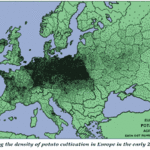Ecology & Zoology

Continuing on the whale theme today, an Australian couple has had an extraordinary windfall: walking along a remote beach they found 32-pounds of sperm whale puke, for which the proper scientific word is ambergris and the technical details are that ambergris is a solid waxy substance originating in the intestine of the sperm whale (Physeter catodon). At first this may seem like a disgusting curiosity worth no more than a moment of notice for its scientific value, but in fact the monetary value of the discovery is estimated to be over $1 million USD!Ambergris, often referred to as ‘…

A team of researchers has documented major changes in the behavior, ecology, and geographic range of the northern fur seal over the past 1,500 years using a combination of techniques from archaeology, biochemistry, and ecology. Among their findings is evidence of reproductive behavior in the past that is not seen in modern populations of northern fur seals.
"We were able to reconstruct this species' prehistoric range and see changes in biogeography and behavior over timescales longer than ecologists usually think about," said Seth Newsome, who worked on the study as a graduate student at the…

B12 is an essential vitamin for and also turns out to be an essential ingredient for growing marine plants that are critical to the ocean food web and Earth's climate, scientists have found.
The presence or absence of B12 in the ocean plays a vital and previously overlooked role in determining where, how much, and what kinds of microscopic algae (called phytoplankton) will bloom in the sea, according to a study published in the May issue of the journal Limnology and Oceanography.
These photosynthesizing plants, in turn, have a critical impact on Earth's climate: They draw huge amounts of…
If you have Mom's smile, Dad's eyes and Grandpa's laugh, you might wonder what other traits you picked up from the genealogic fabric of the ol' family tree.
Scientists at the Texas A&M University System Agricultural Research and Extension at Lubbock are studying the family tree of cotton for much the same reason.
Mark Arnold, Experiment Station research associate, looks for thrips damage on young cotton plants. Identifying resistant and non-resistant cotton lines (top right) will help breeders develop varieties that can withstand thrips feeding damage to the first four true seedling…

Scientists have found hundreds of new marine creatures in the vast, dark deep-sea surrounding Antarctica. Carnivorous sponges, free-swimming worms, crustaceans, and molluscs living in the Weddell Sea provide new insights into the evolution of ocean life.
They describe how creatures in the deeper parts of the Southern Ocean - the source for much of the deep water in the world ocean – are likely to be related to animals living in both the adjacent shallower waters and in other parts of the deep ocean.
A key question for scientists is whether shallow water species colonised the deep ocean or…

Molecular studies recently revealed new genetic information concerning the long-disputed origin of the “European potato.” Scientists from the University of Wisconsin-Madison, the University of La Laguna, and the International Potato Center used genetic markers to prove that the remnants of the earliest known landraces of the European potato are of Andean and Chilean origin.
“European potatoes,” the cultivated potatoes first appearing in Europe and later spreading worldwide, were first recorded outside of the Americas in 1567 on the Canary Islands Archipelago. Today, scientists believe that…

Rooted in place, plants can't run from herbivores—but they can fight back. Sensing attack, plants frequently generate toxins, emit volatile chemicals to attract the pest's natural enemies, or launch other defensive tactics.
Researchers have identified a specific class of small peptide elicitors, or plant defense signals, that help plants react to insect attack.
In this colorful self-defense strategy, proteins already present in the plant are ingested by insect attackers. Digesting the proteins, the insects unwittingly convert this food into a peptide elicitor, which gets secreted back onto…

Some criminals get caught in the act of smuggling strange cargo and are not always very clever about heir tactics. In the United States, wildlife smuggling is the nation’s second-largest black market, (behind narcotics), worth $9 billion a year.
Some of the more interesting highlights seen at Los Angeles International Airport include: In 2006 A Japanese man was arrested for smuggling Queen Alexandra’s birdwings, one of the largest butterflies in the world, worth $8,500 USD. And in the same year four people were accused of trafficking in the endangered dragon fish.
In 2002 A Palm Springs man…

The presence of ecologically distinct males and females greatly increases a species' niche, say researchers.
Some Caribbean lizards' strong sexual dimorphism allows them to colonize much larger niches and habitats than they might otherwise occupy, allowing males and females to avoid competing with each other for resources and setting the stage for the population as a whole to thrive. The finding, reported this week in the journal Nature, suggests sex differences may have fueled the evolutionary flourishing of the Earth's wildly diverse fauna in a way not previously appreciated by scientists…

Researchers have discovered a new fact about hooded seals, a mysterious mammal that spends all but a few days each year in the ocean.
An international team of researchers led by Dr. David Coltman, an evolutionary geneticist at the University of Alberta, have learned that all the hooded seal populations in the world share the same genetic diversity. The researchers reached their conclusions after analysis of more than 20 years of DNA samples taken from hundreds of hooded seals from around the world.
"These results mean that if you brought me a DNA sample of a hooded seal, I wouldn't be able…